Contractor trucks and equipment consume a fair amount of fuel. While our expenditures on fuel aren’t as dramatic as some industries in the transportation sector, we still notice the difference on our truck fleet especially. The cost of diesel for example, has jumped almost a dollar in the past couple of months, to an astonishing price of over $5.00 per gallon in California.
Category Archives: General Commentary
Stonehenge in a Backyard
An amazing video showing how one man from Flint, Michigan is able to move Stonehenge sized concrete lintels alone, using only leverage and other simple mechanisms. Makes our projects moving boulders and trees using equipment seem easy by comparison.
Sprint/Nextel’s Woes
Sometimes in retrospect you can look back and be glad in the judgment of having made a correct decision. Our company’s decision to switch from Nextel to Verizon a couple of years back was one of these instances. I read with interest in the Wall Street Journal of Sprint/Nextel’s huge 30 billion loss in the previous quarter, due largely in part to a write down in the value of the Nextel division. Our company’s experience with Nextel has been well chronicled here in the past, and I was in no way surprised to learn of Nextel’s difficulties. For the scores of other construction companies who still use Nextel, the question has to be asked, is it time to get off a sinking ship?
Drainage Check
This is the time of year where hidden elements like drainage and roofing that go unnoticed most of the year can become the focus of attention. When there are feet of standing water in the crawl space or water pouring through the skylight, their importance become obvious.
We just finished an extensive drainage system for a commercial project where we installed over a thousand feet of drainage line and twenty new catch basins to solve drainage problems around the project site. Having a drainage system that provides a finished solution is an important consideration. Unless the system collects and removes or segregates all the draiange water out of critical areas, it can function to treat the problem but not solve it. For example, a system that pumps water out of a flooded crawl space or basement is less effective and higher maintenance than a French drain or other surface drainage system that stops the water penetration in the first place. Sometimes this type of solution isn’t possible due to site conditions or topography. In most cases though, while it may cost a bit more the short run, the system that can most effectively deal with drainage issues is going to perform the best in the long term.
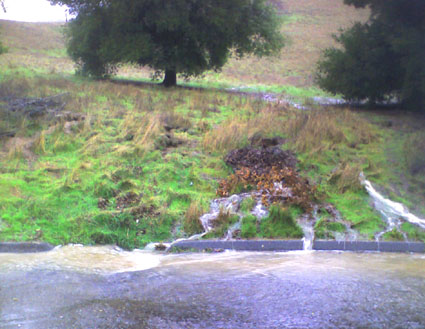
Good Rain, Bad Rain
We make a morning call to determine if we are going to work in the field on mornings like this. Turned out we made the right call yesterday by deciding not to work today. The traffic and conditions have been terrible as a result of last night and today’s storm. The good news is the reservoirs will be filled and we could use the rain. The bad news, with 580 and 101 closed, flooded, and delayed it has been a mess of a day on the roads.
Keeping Those New Year’s Resolutions
Well another year is upon us, and with it comes the tradition of making New Year’s resolutions. We make resolutions as a company, helping us focus on improving our systems, service, and employees. After reading an article in the San Francisco Chronicle, it turns out this is something most small businesses do. The Chronicle article had some interesting tips for setting goals for the New Year as a business.
Another good source of inspiration, whether it is spending more time in the garden or launching a new company is David Allen and his Getting Things Done methodology. We’re big fans!
Other tools we’ve found for the New Year: the MeeTimer for the Firefox Browser, which help track and cut back wasted time online, and the Google suite of tools- Notebook, Calendar, etc.
2008 Calendar
We are mailing our annual calendar, “A Year in Bloom” for 2008. This year features colorful closeups of a variety of plants in bloom.
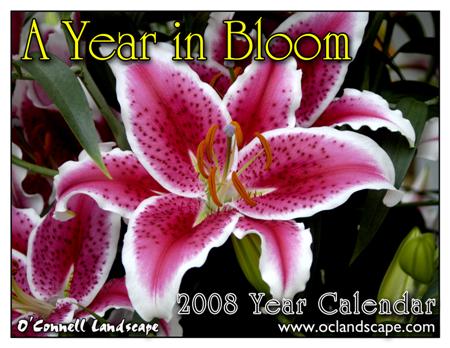


New Jersey Dog Controversy
There is an article in the New York Times today concerning a dog attack on a landscape laborer in New Jersey. There has been a great deal of controversy in the state over putting the German Shepard down after the attack. State law requires that a dog be put down after an unprovoked attack, but supporters are trying to get a pardon from the governor:
State Assemblyman Neil M. Cohen, a Democrat from Union, has introduced legislation, which he calls Congo’s Law, that could spare the life of Congo and other dogs in similar situations by giving judges more discretion in meting out
punishment.And now, thousands of people from Princeton and elsewhere are petitioning thegovernor for a pardon. (There is precedent for such things in New Jersey.)
In a letter to The Princeton Packet on Tuesday, a resident, Jonathan Eckstein, wrote: “I urge the State Legislature to vote down this absurd legislation and put the rights of human beings like Mr. Rivera above those of domestic animals, however tragically misunderstood. I would hate my hometown and
home state to go down in history as the place where suburbanites valued their dogs above the lives of those they hire to tend their yards.”
From past experience, it can be a bit tricky working on landscape projects with dogs, who can be defensive of their owners or territory.
Mapping the Bay Oil Spill
As with the fires that ravaged Southern California, Google Maps customizable features are being utilized to geographically map the environmental effects of the Cosco Busan oil spill in San Francisco Bay. The Chronicle has a map up that links stories and photos from various sites around the bay- worth a look.
 For more information on Volunteer Opportunities related to the oil spill check the Golden Gate National Park Conservancy Website
For more information on Volunteer Opportunities related to the oil spill check the Golden Gate National Park Conservancy Website
Get Ready Marin
For those driving around Marin, you may have noticed the ubiquitous yellow banners for Marin’s disaster preparedness drive Get Ready Marin. With the recent earthquake in the area and the Southern California wildfires, taking a look at the drive’s website for preparedness tips may not be a bad idea. On the site they information on what types of supplies to stock-up on, and information and guides for fire, earthquake, and flooding disasters.
Firescaping
 The firestorms that are raging through Southern California provide a good reminder on why planning for fire in landscaping your home is an important consideration, especially in the arid west. In Marin County there are several densely wooded areas, in Fairfax and Mill Valley especially, that are very suceptible to fire. There are a few key considerations that can help reduce fire risk in the event of a major blaze. Having defensible space where vegetation is cleared around the home is a key consideration. Removing pyrophitic vegetation close to the home, such as Eucalyptus, Pines, and Junipers can also help. For example, the city of San Rafael recently passed an ordinance requiring the removal of all bamboo and junipers within 100′ of structures by 2011.
The firestorms that are raging through Southern California provide a good reminder on why planning for fire in landscaping your home is an important consideration, especially in the arid west. In Marin County there are several densely wooded areas, in Fairfax and Mill Valley especially, that are very suceptible to fire. There are a few key considerations that can help reduce fire risk in the event of a major blaze. Having defensible space where vegetation is cleared around the home is a key consideration. Removing pyrophitic vegetation close to the home, such as Eucalyptus, Pines, and Junipers can also help. For example, the city of San Rafael recently passed an ordinance requiring the removal of all bamboo and junipers within 100′ of structures by 2011.
Firesafe Marin has these important tips:
Planning
- Assess your fire risk. Is your home on a hill? Are you near highly flammable native vegetation or drought-damaged ornamental plants? If your answer is yes, your fire risk is greater than average.
- Contact your local fire department for fire hazard ratings in your neighborhood.
- Plan your landscape to reduce the amount of flammable vegetation nearest your home. Establish defensible space.
- Consider consulting your local nursery or a landscape contractor to help plan your landscape.
Spacing
- Eliminate the “fire ladder.” Fire needs fuel to burn. You can sap its strength by robbing it of the continuous sequence of vegetation that can carry flames from your landscape to your house.
- Group plants of similar height and water requirements to create a “landscape mosaic” that can slow the spread of fire and use water most efficiently.
- Space trees at least 10 feet apart, and keep branches trimmed at least 10 feet from your roof. For trees taller than 18 feet, prune lower branches within six feet of the ground.
- Install fire resistant, drought-tolerant plants that have a high moisture content. Use plants that do not accumulate dead leaves or twigs.
- Use masonry or stone walls to separate plant groups and add variety to your landscape.
Watering- Choose the right irrigation system. While all plants will eventually burn, healthy plants burn less quickly. Your plant selection and water availability will determine the right system for you.
- Consider drip irrigation for watering most of your landscape. It’s effective and conserves water because it targets where the water goes and how much gets there.
- Use sprinklers for lawns or turf landscaping. Drip irrigation does not work well on lawns. Sprinklers on timers ensure your lawn is getting the right amount of water to keep it healthy and fire resistant.
Maintenance
- Keep your landscape healthy and clean. On a regular basis, remove dead branches, leaves and pine needles from your yard. These can serve as added fuel to a fire.
- Prune and thin shrubs, trees and other plants to minimize the fuel load.
- Be diligent about cleaning up, especially during fire season. Remove dead leaves from under the plants as well.
- Involve your gardener. If a gardener cares for your property, ask him or her to include these regular maintenance steps as part of the routine service.
- Recycle/compost plant materials. Participate in your community’s green waste recycling program. You can also compost plant litter and create a money-saving alternative to store-bought soil and mulch. Grass cycling is another time and money saving way to make your green waste work for you.
For More:
Fire Resistant Plants– Adobe Acrobat file .pdf, Lists from MMWD and Fire Safe Marin
New City of San Rafael Fire Ordinance
Top 100 Architecture Blogs
Our blog was recently listed in the top 100 architecture blogs by International Listings, a site dedicated to world wide real estate information and listings. The have some interesting articles, and there are lots of good sites on the top 100 list- worth a look.
Mobile Productivity & Orb
I just upgraded to a different Smartphone and have been working on ways to get it up and running (email, Outlook Contacts etc.). One of the most amazing services that I encountered is Orb, which is mainly designed to stream music and video to mobile devices. Orb essentially turns your main computer into a server that can be accessed via the web. The great aspect of Orb, besides it being
free, is you can also share documents.
I can be out in the field, needing to check the contract for the Jones
project, and log into my PC via the web and download the document to my phone (and listen to the Rolling Stones from PC while doing it). While there are sometimes bugs in transferring the information, this is a pretty amazing service.

Viewing a .pdf file of lighting specification sheet pulled from a desktop computer on a Smartphone
Time for the Plastic Tarps
With October rains upon us, it is time to get out the plastic tarps, rain suits and boots to deal with the weather. We typically try to work even on rainy days; although if it is pouring there’s not a lot we can do. We will frequently construct tent structures so we can continue work setting flagstone or building retaining walls.
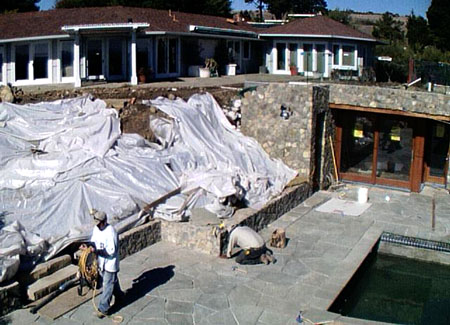
Our Blog is Back!
Our Blog is back after some downtime due to a server change and blogging software upgrade. Now it’s just a matter of trying to put everything back together again under this new blogging platform. Please be patient as we get everything straightened out and stay tuned!
Shop Where the Pros Shop
Walking the aisles at a home improvement store last week, I noticed the marked difference between the quality of components and parts for irrigation systems and lights. While they may be cheaper, the parts aren’t nearly the same quality as those we install in our landscapes.
Fortunately, the easy solution is to shop at an irrigation specialty store, such as Horizon or Ewing. Both have a comprehensive selection of irrigation, landscape and lighting equipment. They also have professional expertise to help with projects, which you won’t find at a big box store. Both vendors also have great websites where you can browse and even shop online.
Matching Contribution Program Donation
A current client took advantage of our Matching Contribution Program, we donated a $500 matching contribution to the Mount Tamalpais School. The school, a non-profit independent school in Mill Valley, offers instruction for grades K-8.
Know Thy Project (Wants & Budget)
After participating in forum with local contractors and garden designers, the subject of client wants and budget planning was a key part of the discussion. As the client going into a new landscape project (and major investment of time and money), the more informed you are, the better off you are in terms of creating a successful project. A successful project is not only one where when people step into the back yard and there is a jaw drop and wow factor. A successful project is also one that is done on time and on budget, with a good contractor and/or designer, with high quality craftsmanship that delivers on your needs.
To achieve a successful landscape project there are a couple of key elements that require some thought(preferably prior to starting the process):
1- Wants: What do you want for your new landscape/garden? Do you want the English Country Garden that you have been brainstorming about with cutouts from Sunset Magazine? Do you want a utilitarian space that solves some of your yard’s problems and makes the space more usable- a place to play, to barbecue, to entertain, to store? At a minimum, develop a general overview of your wants and write them down- share them with your contractor and designer.
2- Budget: How much do you want to spend? This is a tough question, you may not know anything about the cost of landscape projects. Can I get my landscape project done for $10,000, for $50,000, more? Do research in magazines, with friends and neighbors, call local contractors, relate experience from past home improvement projects.
Once these first planning steps have been accomplished now its time to put together a great team to design and build the project. Key factors are finding professionals that are going to be easy to work with, provide good service, and deliver a quality project. Interview contractors and designers through consultations to find a good fit. Nothing can sidetrack your project faster than getting a contractor who doesn’t respond to phone calls, doesn’t follow-up on promises and doesn’t perform quality work.
Next Steps: Read our past articles on budget and selecting a contractor-
“How Much Does it Cost- Budget and Landscape Projects”
Hawk Hunting
From somewhere other than work… Happy holidays, merry Christmas, Hanukkah and a great 2007!
Winter Time is Drainage Time
Driving from a hillside project this morning, I snapped the the photo below- water pouring over a wood retaining wall. This time of year, scenes like this underscore the importance of good drainage. The solution in this situation, a gravel drainage field and perforated pipe would absorb this surface water and solve the problem. It is possible that this is being caused by existing drainage lines, but it would be a better solution if they didn’t daylight over the wall.
Common Landscape Mistakes: Fences
A continuing entry in our Common Landscape Mistakes series:
Fences are a fairly basic element in landscape construction, but one where we see common mistakes in design and construction. Here is a guide to fence types and ways to avoid common mistakes.
Proper construction of fencing really depends on the type of fence being installed.
The basic fence types are as follows:
1 -Perimeter Fence- metal, wood or wood and wire. Typically constructed for privacy on back or side yards. Heights typically 4-6’
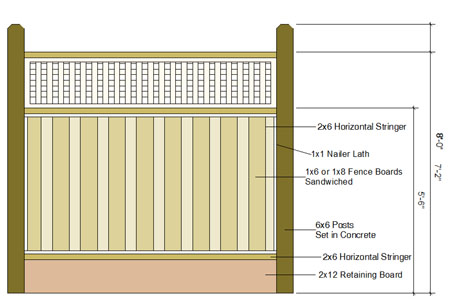
8′ Fence with Lattice
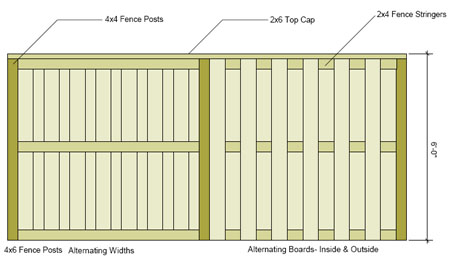
Examples of Standard 6′ Fence and Alternating Board “Good Neighbor Fence”
2 -Front Fence- Typically a picket style, or semi-transparent design, heights typically to 3-4’
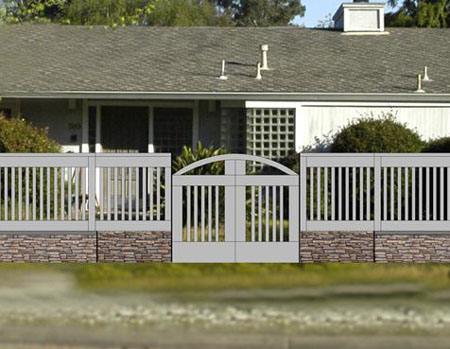
Mock-up of vertical picket fence on top of wall
3-Deer Fence- to restrict deer access, typically wood and wire, or wire and Metal T-post construction, heights typically 4-6’
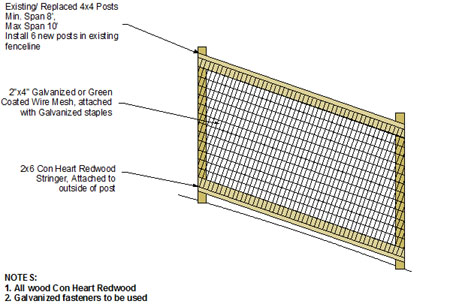
Wood and Wire Deer Fence on Sloped Terrain
4-Railing: Typically wood, tensioned cable, or prefabricated metal. Heights typically to 3’
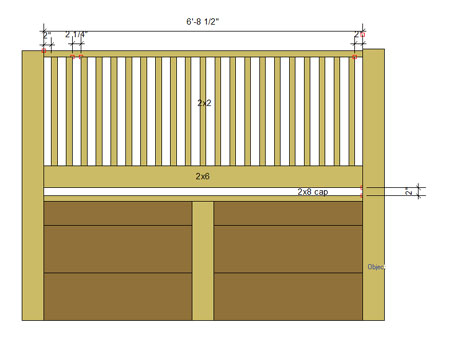
Wood Railing on Top of Retaining Wall
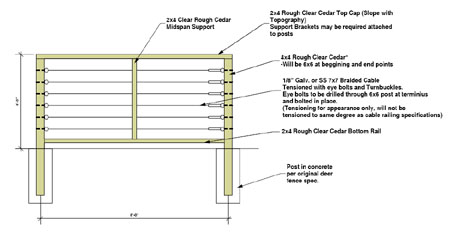
Cable Railing with Wood Frame
Construction: Fences are composed of a few key elements-
-Posts: typically set in concrete
-Stringers: Horizontal boards connecting posts
-Fill: Fence Boards, wire mesh, tensioned wire, etc.
-Decorative elements: Wood lattice, extended trellises, kicker boards, decorative detailing
Biggest Mistakes:
Here a few of the most common fence construction mistakes we see:
1-Horizontal Stringers: 2×4 boards are the most common stringers used in fencing. These boards typically span posts, spaced 8’ on center. Because wood at this span will have a tendency to sag, it is important that the strongest orientation of the board is used- in this case the 4” side, not the 2” side. Horizontally oriented 2×4 stringers spaced at 8’ spacing will show a noticeable bow over time.
-Insufficient stringers- we prefer 3 stringers for some styles of fence, especially over 6’. There are some fence designs where 2 stringers are insufficient.
2- Poor Posts:If the style will allow, pressure treated posts can be used to help resist weathering. In cases of finished fencing, a decay resistant wood such as redwood or cedar should be used. Untreated wood used outside will weather and decay rapidly. Post should be set in concrete, typically 9-12” in diameter and at a typical minimum of 18” in depth, with gravel installed at the base of the base pier to allow water to escape. Posts poorly set, will result in a structurally unstable fence, that will likely lean, or blow over in a storm.
3- Ugly Styling: Some fences are just downright ugly. Take a look in your neighborhood to find fences that have a good style of construction and a good aesthetic.
4- Poor fastening: screws or nails can be used for fastening the fence depending on application. Nails and screws should be galvanized at a minimum to prevent excessive rust and weathering; on high quality fencing stainless steel screws or nails should be used.
5-Too tall: Fences over 6’ need special construction considerations- 4×4 posts are typically not strong enough, 4×6 or 6×6 posts should be used. Sufficient stringers should be used on tall fences, 1” thick fence boards should not exceed a 5-6’ span vertically between stringers, if they do, they are likely to warp. Check also with your local building department, frequently fences over 6’ require permitting (sometimes 2’ of wood trellis is allowed, totaling 8’)
Our 2007 Calendar
Our 2007 Calendars, Everything in Black & White, will be mailing out soon. This year’s calendar features, well, black and white photography. If you would like a free copy of the calendar please send us an email with your name and address.
Enjoy a great holiday season!
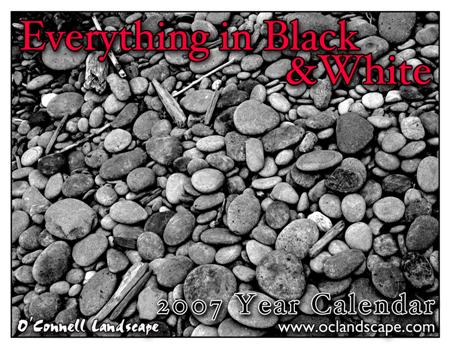
This Year’s Cover
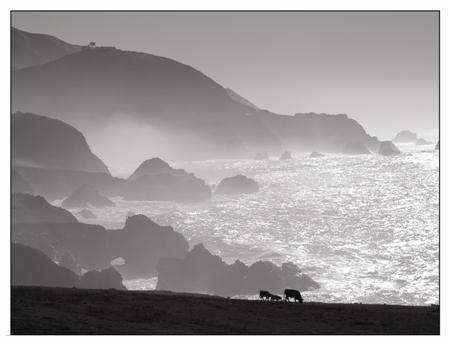
Some of the monthly images
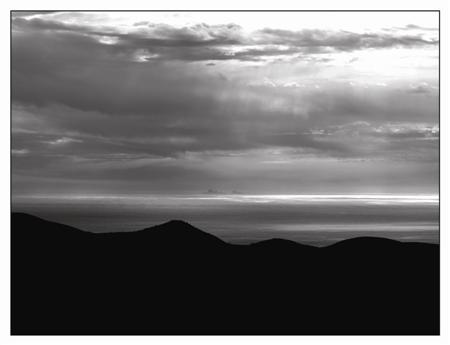
Common Mistakes: Don’t Paint that Concrete!
A continuing entry in our Common Landscape Mistakes series:
It might seem like a good idea, but painting concrete rarely turns out well. From time to time I see concrete walkways or driveways that have been painted over. Painting can make an old outdoor concrete surface look new for a while, but the drawbacks are numerous. Painted concrete chips and fades considerably, almost guaranteeing that in a couple of years that nice consistent looking surface is going to be faded, stained, and flaking. Painting concrete also usually reduces the roughness of the surface, making it more likely someone will slip on the smooth surface when wet. In addition to these draw backs, because it’s not done very often, painted concrete often looks strange in the landscape. Unless an earth-tone is selected, the color often stands looking strange in the context of the neighborhood.
Alternatives to painting are replacing the existing concrete with new colored concrete. Or, if the concrete is in good shape, there are specialized concrete stains available that can add color while not flaking or reducing traction on the material.
It’s Masonry!
Here is a bit of a humorous note for a Friday- one of my little irritations (excuse me while I get on my soapbox) is the mispronunciation of the word masonry.
Masonry being defined as: work constructed by a mason, esp. stonework: the crumbling masonry of ancient walls.
I frequently hear subcontractors and other contractors refer to the craft of the noble mason as “masonary”, which unless they are using some sort of masonry mercenaries is incorrect- it’s masonry!
Some of our “Masonaries” on a current project
Common Landscape Mistakes: Overplanting
In posts this week we are going to focus on some common detailing mistakes made by homeowners and professionals alike in residential landscaping. Some of these are little things, some are major errors, but all are good things to be aware of when working on landscape projects.
Common Landscape Mistake: Overplanting
This is a common problem we see in residential landscape projects, planting too densely or not realizing the mature size of plantings being installed. To a certain degree this can be stylistic and subjective, some people prefer dense plantings, but at times it can look downright comical. Often wanting things to look good right away, plants are planted too close for their mature sizes. Also, frequently shrubs are planted too close together. For example an Angel’s Trumpet is planted 2.5′ away from a Butterfly Bush, both of which can grow to 6’x6′ in size. The most important thing is to remember to balance the immediate impact of plantings with their more mature look in 2-3 years.
Frequent plant spacings (on center)
1-2′ Small flowering perennials and annuals
2-3′ Woody shrublets, small shrubs, most grasses
4-6′ Larger shrubs, hedging shrubs, large grasses
8-12′ Small scale trees, aggressive vines, aerial and regular hedging shrubs
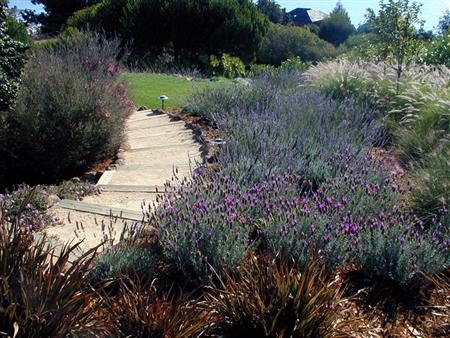
Dense plantings aren’t always a problem- with these Lavender and grasses, tighter groups are desirable for distinct massings.
Notice the same planting about 18 months before, when the plantings had first gone in. The Lavender here is planted between 2-3′ apart, but just coming out of the container the planting still looks insignificant.
These ornamental grasses and New Zealand Flaxes are another example of density used properly. Problems can arise when larger shrubs with courser texture are planted in the same way.
The Green Wall of Mongolia
There was a fascinating article in the Wall Street Journal (subscription required) today about efforts in Mongolia to fight sand storms in the Gobi Desert that are progressively becoming worse (expanding goat herds and global warming being two main culprits). The storms frequently blanket Beijing with sand and dust, with material and haze ending up as far afield as Utah.
The solution, a $150 million dollar project to plant Alders, Junipers and other hardy plants (temperatures range in the Gobi from -40 degrees F to 110) in a huge windbreak across the country to help control the storms and dust. Experts are skeptical whether the endeavor will be successful, but Mongolians are hopeful the vegetation project will make a difference in controlling the storms.
Like any vegetation project, the difficulty lies in getting the trees and shrubs to establish and be maintained over the long term. In a couple of decades we may be referring to a second Asian wonder, the “Green Wall of Mongolia.”

Image from Wikipedia
The Mundane Is Important
Working in conjunction with a general contractor on an aspect of a construction project produced the following revision to a concrete paving pattern. The revision was different than an earlier conceptual scheme for the walkway in some small alignment details. While the builder commented that the adjustments could be made in the field, my experience has always been that clarity and specificity on paper save headaches later on.
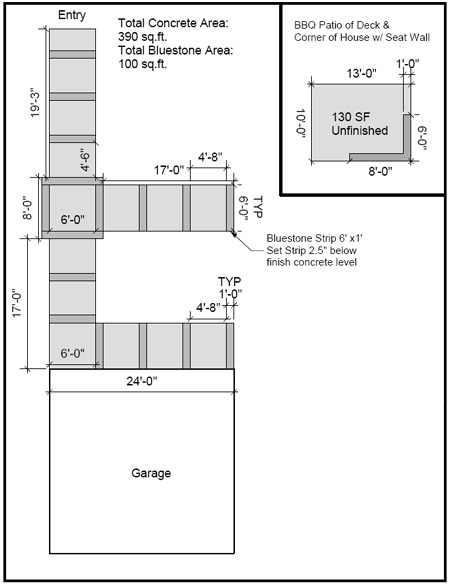
To quote the architect Le Corbusier- God is in the details.
Low Voltage Lighting Systems and Energy Requirements
The State of California put into effect new energy regulations, Title 24, that regulate energy usage of light fixtures installed in commercial and residential settings. One point of confusion is the application of the new law, which went into effect last October, on low voltage landscape lighting systems.
Exterior lights mounted on buildings have a variety of new restrictions regarding fixture energy efficiency, photocells, and motion detection equipment. Fortunately, these new restrictions don’t apply to landscape lighting systems. To quote the California Title 24 Residential Compliance Manual,
“Example 6-15
Question
My House has a row of small incandescent bollards along the walk way to the front door. Do these have to be high efficacy?
Answer
No. The high efficacy requirement only applies to lighting mounted to the building.
Example 6-16
Question
I would like to install low-voltage landscape lighting in my yard. Are these required to be on a motion sensor and photocontrol?
Answer
No. Even though low-voltage lighting does not qualify as high efficacy lighting, lighting not attached to a building, like landscape lighting, is exempt from this requirement.”
These exemptions make sense, because landscape lighting is in a completely different class of application and energy use than other residential and commercial lighting.
Posted by Michael O’Connell at 07:18 PM | Comments (0)
Fall Is In The Air
There definitely is a feeling of fall in the air here in Northern California. People often lament a lack of seasons here in California, but they are still here, if a bit more subtle. The days are growing shorter, our Indian summer October weather is here today, and of course the trees are turning. Striking specimens this time of year are Chinese Pistache and Liquid Ambar; two trees that dependably color this time of year.
It is always amusing when planting people’s yards how they are drawn to plants in season. In the fall people want to plant Crape Myrtles and Japanese Maples, in the spring its Flowering Cherry and other blooming fruit trees. Most trees that have this seasonal interest do go deciduous and drop their leaves- thus emerging or departing all the more spectacularly.
Remembering the Rain
With a feeling of fall in the air and showers descending on the North Bay this morning, we are jolted back to the reality of working in the rainy half of the year. All things considered, California’s Mediterranean climate affords an amazing opportunity to work year round. This is without threats of snow or freezing temperatures endured by most of the rest of the country. Still, working in the summer has the benefit of not staring at 10 day forecasts or satellite and doppler radar each morning.
Working in wet weather will typically slow the pace of landscape projects, but most items can be continued on in the rain; with notable exceptions being large excavation in heavy rain and finished concrete. The other benefit of the onset of fall is being able to start to turn down sprinkler systems from the summer watering schedule.
For More:
“Dealing with Rain in Landscape Projects”
Weather.com – 10 Day Forecast (San Rafael), Western Satellite/Doppler
